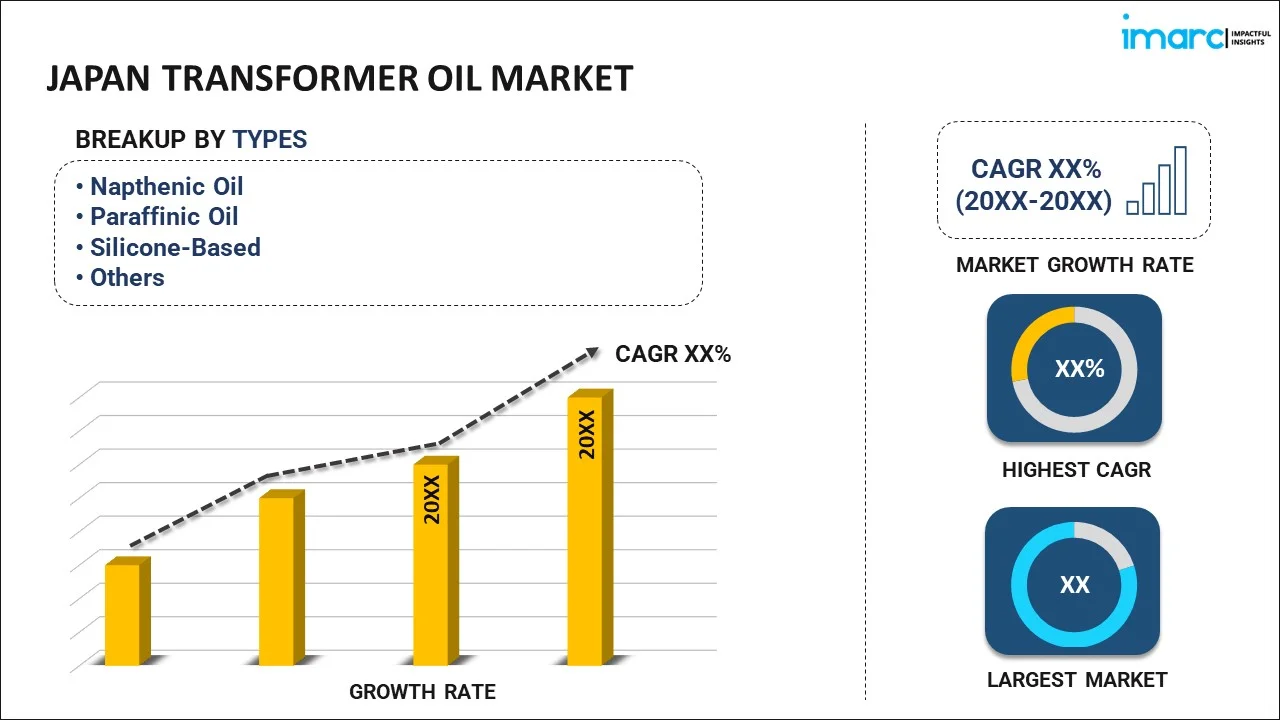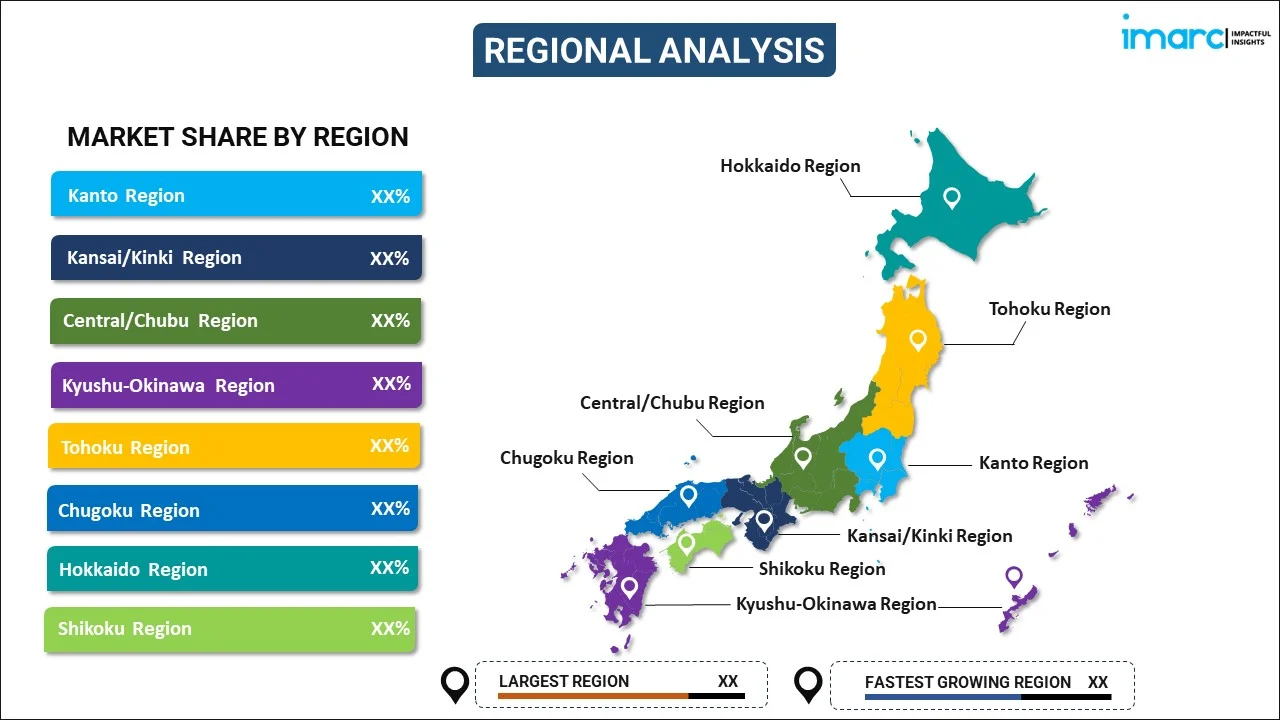
Japan Transformer Oil Market Report by Type (Napthenic Oil, Paraffinic Oil, Silicone-Based, Bio-Based, and Others), Function (Insulator, Cooling Agent, Lubricant, Chemical Stabilizer), End Use (Small Transformers, Large Transformers, Utility, and Others), Application (Residential, Commercial, Industrial), and Region 2025-2033
Market Overview:
Japan transformer oil market size reached USD 57.5 Million in 2024. Looking forward, IMARC Group expects the market to reach USD 87.7 Million by 2033, exhibiting a growth rate (CAGR) of 4.40% during 2025-2033. The increasing integration of renewable energy sources such as wind and solar power into the electrical grid, which requires the installation of new transformers and substations, is driving the market.
|
Report Attribute
|
Key Statistics
|
|---|---|
|
Base Year
|
2024 |
|
Forecast Years
|
2025-2033
|
|
Historical Years
|
2019-2024
|
| Market Size in 2024 | USD 57.5 Million |
| Market Forecast in 2033 | USD 87.7 Million |
| Market Growth Rate (2025-2033) | 4.40% |
Transformer oil, also known as insulating oil or mineral oil, is a specialized type of oil used in electrical transformers and other high-voltage equipment. Its primary purpose is to provide electrical insulation and cooling to these devices. Transformer oil possesses excellent dielectric properties, meaning it can withstand high electrical voltages without breaking down. This oil serves a dual function in transformers. Firstly, it insulates the electrical components, preventing electrical discharges, arcing, and short circuits. Secondly, it acts as a coolant, dissipating heat generated during the operation of the transformer. This cooling property is crucial to maintain the transformer's efficiency and prolong its lifespan. Transformer oil is typically a highly refined mineral oil, although some transformers may use synthetic oils with enhanced properties. It undergoes rigorous purification processes to remove impurities and moisture, ensuring its reliability in electrical systems. Routine testing and maintenance of transformer oil are essential to monitor its quality and ensure the safety and efficiency of electrical equipment.
Japan Transformer Oil Market Trends:
The transformer oil market in Japan is poised for substantial growth, primarily due to several key drivers that have been propelling the industry forward. Firstly, the increasing demand for electricity has been a pivotal factor in stimulating the market's expansion. As populations grow and industrialization spreads, the need for efficient and reliable power distribution systems has become paramount. Consequently, the maintenance and optimization of transformers, where transformer oil plays a critical role, have gained significant attention. Moreover, the aging power infrastructure in many regions has led to a surge in transformer replacements and retrofits, further fueling the demand for transformer oil. This trend is accompanied by stringent regulations and standards governing transformer oil quality, promoting the adoption of high-performance and environmentally friendly formulations. Additionally, the growing adoption of renewable energy sources, such as wind and solar power, which often require transformers for efficient energy conversion and distribution, is expected to drive the transformer oil market in Japan during the forecast period.
Japan Transformer Oil Market Segmentation:
IMARC Group provides an analysis of the key trends in each segment of the market, along with forecasts for the country level for 2025-2033. Our report has categorized the market based on type, function, end use, and application.
Type Insights:

- Napthenic Oil
- Paraffinic Oil
- Silicone-Based
- Bio-Based
- Others
The report has provided a detailed breakup and analysis of the market based on the type. This includes napthenic oil, paraffinic oil, silicone-based, bio-based, and others.
Function Insights:
- Insulator
- Cooling Agent
- Lubricant
- Chemical Stabilizer
A detailed breakup and analysis of the market based on the function have also been provided in the report. This includes insulator, cooling agent, lubricant, and chemical stabilizer.
End Use Insights:
- Small Transformers
- Large Transformers
- Utility
- Others
The report has provided a detailed breakup and analysis of the market based on the end use. This includes small transformers, large transformers, utility, and others.
Application Insights:
- Residential
- Commercial
- Industrial
A detailed breakup and analysis of the market based on the application have also been provided in the report. This includes residential, commercial, and industrial.
Regional Insights:

- Kanto Region
- Kansai/Kinki Region
- Central/ Chubu Region
- Kyushu-Okinawa Region
- Tohoku Region
- Chugoku Region
- Hokkaido Region
- Shikoku Region
The report has also provided a comprehensive analysis of all the major regional markets, which include Kanto Region, Kansai/Kinki Region, Central/ Chubu Region, Kyushu-Okinawa Region, Tohoku Region, Chugoku Region, Hokkaido Region, and Shikoku Region.
Competitive Landscape:
The market research report has also provided a comprehensive analysis of the competitive landscape. Competitive analysis such as market structure, key player positioning, top winning strategies, competitive dashboard, and company evaluation quadrant has been covered in the report. Also, detailed profiles of all major companies have been provided.
Japan Transformer Oil Market Report Coverage:
| Report Features | Details |
|---|---|
| Base Year of the Analysis | 2024 |
| Historical Period | 2019-2024 |
| Forecast Period | 2025-2033 |
| Units | Million USD |
| Scope of the Report | Exploration of Historical and Forecast Trends, Industry Catalysts and Challenges, Segment-Wise Historical and Predictive Market Assessment:
|
| Types Covered | Napthenic Oil, Paraffinic Oil, Silicone-Based, Bio-Based, Others |
| Functions Covered | Insulator, Cooling Agent, Lubricant, Chemical Stabilizer |
| End Uses Covered | Small Transformers, Large Transformers, Utility, Others |
| Applications Covered | Residential, Commercial, Industrial |
| Regions Covered | Kanto Region, Kansai/Kinki Region, Central/ Chubu Region, Kyushu-Okinawa Region, Tohoku Region, Chugoku Region, Hokkaido Region, Shikoku Region |
| Customization Scope | 10% Free Customization |
| Post-Sale Analyst Support | 10-12 Weeks |
| Delivery Format | PDF and Excel through Email (We can also provide the editable version of the report in PPT/Word format on special request) |
Key Questions Answered in This Report:
- How has the Japan transformer oil market performed so far and how will it perform in the coming years?
- What has been the impact of COVID-19 on the Japan transformer oil market?
- What is the breakup of the Japan transformer oil market on the basis of type?
- What is the breakup of the Japan transformer oil market on the basis of function?
- What is the breakup of the Japan transformer oil market on the basis of end use?
- What is the breakup of the Japan transformer oil market on the basis of application?
- What are the various stages in the value chain of the Japan transformer oil market?
- What are the key driving factors and challenges in the Japan transformer oil?
- What is the structure of the Japan transformer oil market and who are the key players?
- What is the degree of competition in the Japan transformer oil market?
Key Benefits for Stakeholders:
- IMARC’s industry report offers a comprehensive quantitative analysis of various market segments, historical and current market trends, market forecasts, and dynamics of the Japan transformer oil market from 2019-2033.
- The research report provides the latest information on the market drivers, challenges, and opportunities in the Japan transformer oil market.
- Porter's five forces analysis assist stakeholders in assessing the impact of new entrants, competitive rivalry, supplier power, buyer power, and the threat of substitution. It helps stakeholders to analyze the level of competition within the Japan transformer oil industry and its attractiveness.
- Competitive landscape allows stakeholders to understand their competitive environment and provides an insight into the current positions of key players in the market.
Need more help?
- Speak to our experienced analysts for insights on the current market scenarios.
- Include additional segments and countries to customize the report as per your requirement.
- Gain an unparalleled competitive advantage in your domain by understanding how to utilize the report and positively impacting your operations and revenue.
- For further assistance, please connect with our analysts.
 Inquire Before Buying
Inquire Before Buying
 Speak to an Analyst
Speak to an Analyst
 Request Brochure
Request Brochure
 Request Customization
Request Customization




.webp)




.webp)












